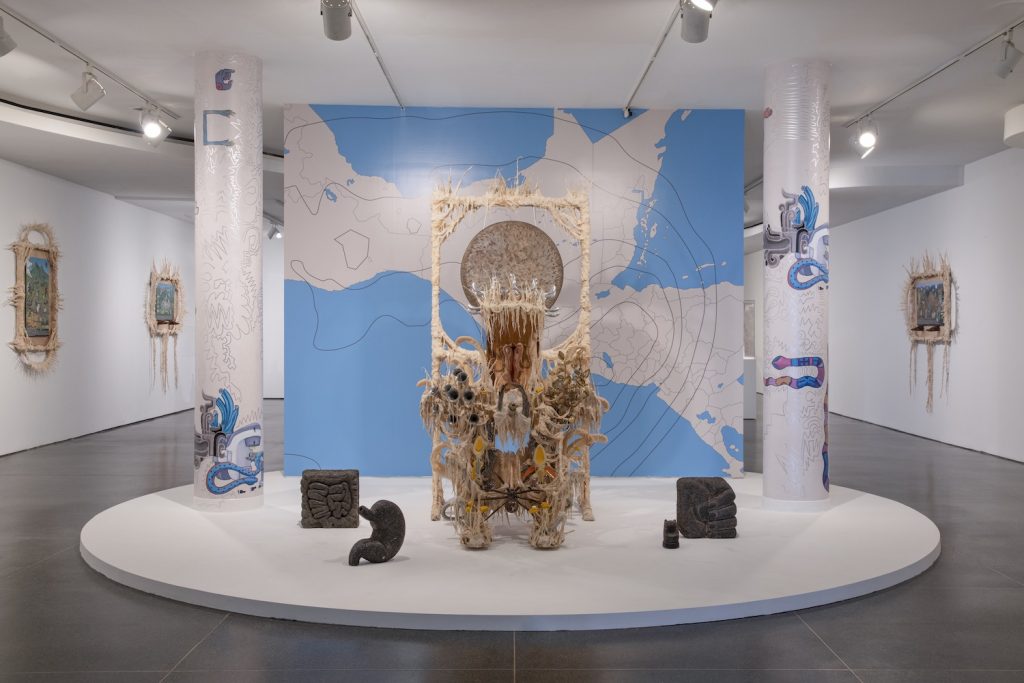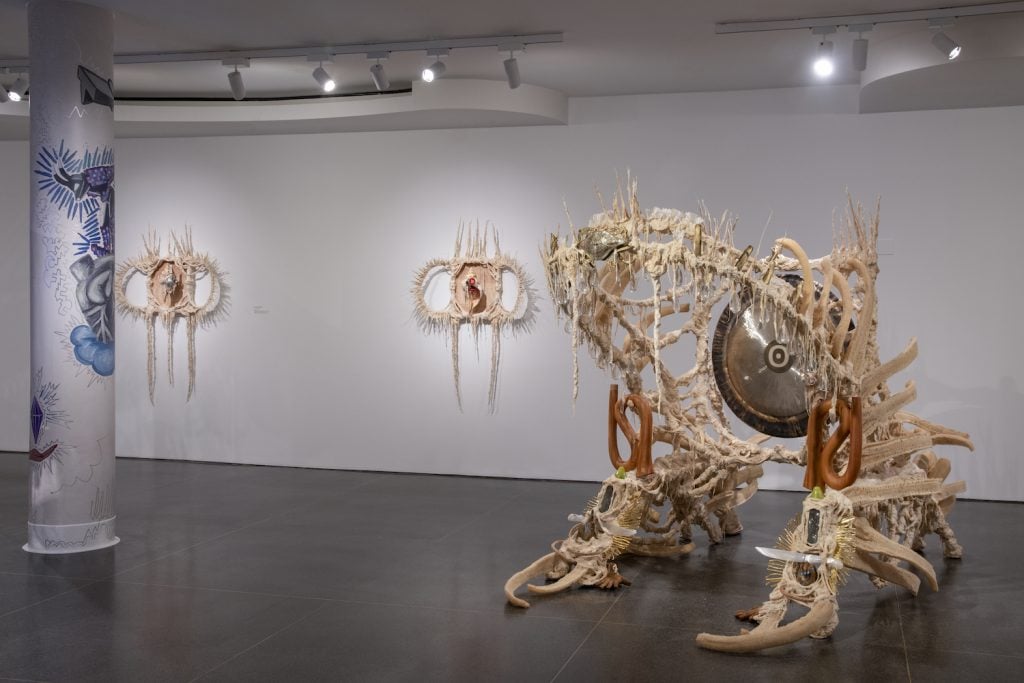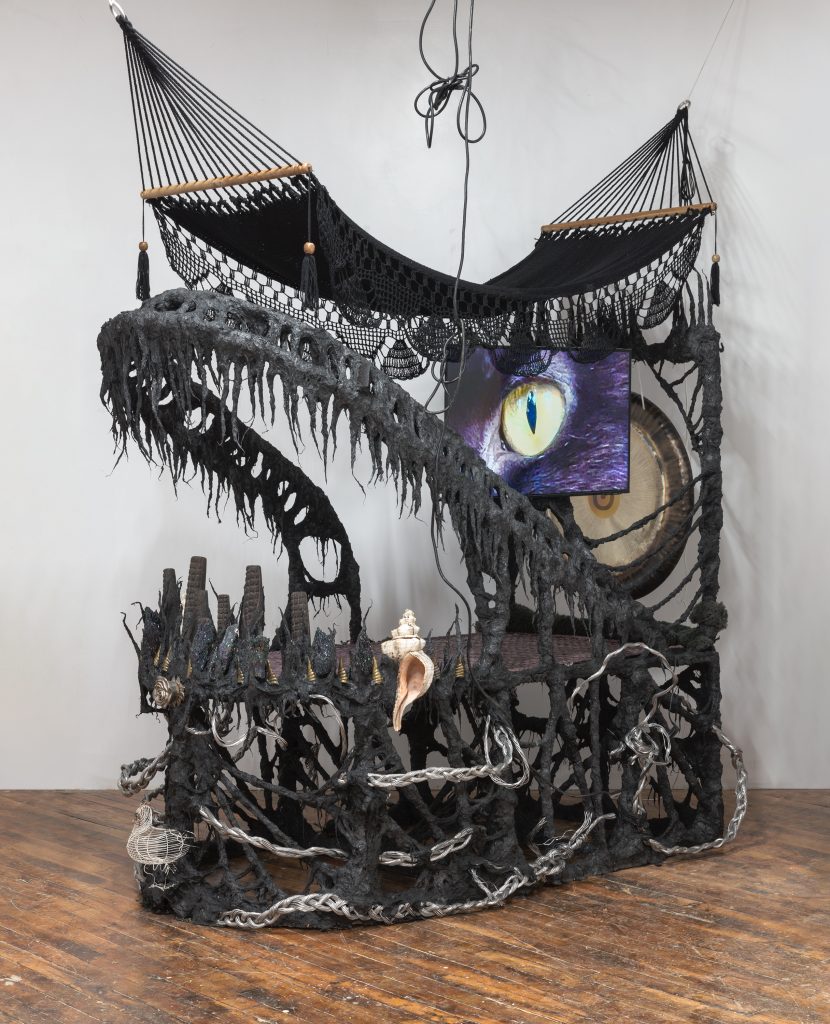On View
How a Salvadorian Children’s Game and a Volcano Inspired Artist Guadalupe Maravilla’s Powerful New Show at the Brooklyn Museum
Maravilla turned to Tripa Chuca as a way to meet others during his migration to the U.S.

Maravilla turned to Tripa Chuca as a way to meet others during his migration to the U.S.

Taylor Dafoe

At age eight, artist Guadalupe Maravilla was among the first group of children to flee from El Salvador when it was divided by a violent civil war. He arrived, undocumented, in the United States, both alone and not—separated from his family but surrounded by strangers bonded by a shared journey.
As a “way to distract myself from the real harsh reality and make a connection with the people I’d just met,” Maravilla turned to Tripa Chuca, a Salvadoran children’s game, the artist told Artnet News.
“I played with the coyotes who were hired to bring me over; I played with the grandmothers that would watch me and take care of me in their houses in New Mexico,” he said. “It’s always been a way to bond with people.”
In the game, participants scribble pairs of numbers on a piece of paper while their opponents connect the pairs with a single stroke, making sure that no lines touch in the process. Emerging eventually is what Maravilla calls a “labyrinth, a topographical map of sorts.”
“To me,” he said, “it starts to feel like a fingerprint between two people that had similar journeys.”

Installation view of “Guadalupe Maravilla: Tierra Blanca Joven,” 2022. Courtesy of the Brooklyn Museum of Art.
As most of his shows do, Maravilla’s new exhibition at the Brooklyn Museum began with a game of Tripa Chuca. The results of the game, played between he and a frequent collaborator who similarly emigrated from El Salvador, greets visitors on a wall at the show’s entrance, teasing the artist’s own transnational perspective.
The show’s title posits an altogether different metaphor. “Tierra Blanca Joven,” as it is called, refers to a volcanic eruption from the fifth century C.E.—among the largest in recorded history—that blanketed a several-thousand-mile stretch of present-day El Salvador with ash and debris, uprooting entire communities of Maya people in the process.
The goal, Maravilla explained, is to draw a connection between the “many different types of displacement” that have occurred in his home country: those induced by an ancient environmental calamity, by a civil war four decades ago, and by ongoing violence in the region today.

Installation view of “Guadalupe Maravilla: Tierra Blanca Joven,” 2022. Courtesy of the Brooklyn Museum of Art.
The idea is echoed, too, in Maravilla’s choice to integrate nearly two dozen ancient Maya figurines, vessels, and other sculptures from the museum’s collection into the show.
“What are these objects doing in Brooklyn?” he recalled thinking upon seeing the Maya artifacts in the institution’s storage rooms. “They were somehow taken from El Salvador in Central America and brought, through multiple hands, to the Brooklyn Museum.”
Maravilla was also drawn to the objects for their one-time connection to customs of healing and ceremony, which is an important aspect of the artist’s own artistic creations.
“My sculptures are an evolution of these ceramics and these objects,” he said. “That’s what has influenced me the most over the years, looking at these ancient rituals from my ancestors.”
A decade ago this December, Maravilla was diagnosed with colon cancer. He ultimately beat the sickness, but the experience—and the rituals he turned to in the process—had a profound impact on his work.

Guadalupe Maravilla, Disease Thrower #0 (2022). Courtesy of the Brooklyn Museum of Art.
Included in the show are three examples of Maravilla’s Disease Thrower series of large, elaborate sculptures inspired by various indigenous healing practices he researched at the time. The most recent of the bunch, Disease Thrower #12122012, was named after the date he was diagnosed.
Made of myriad found materials both organic and man-made (rocks and ropes, animal bones and medical objects, metal gongs) the artworks look imposing, occasionally even monstrous. But they act as sites of rehabilitation: Maravilla frequently employs the sculptures for his own healing rituals with others.
Over the last two years, in particular, the artist held hundreds of healing ceremonies with his work, many for undocumented immigrants in his own New York neighborhood. The pandemic “opened up these doors [making] everyone… aware of how much healing we need to do.”
Shortly after “Tierra Blanca Joven” opened, Maravilla offered something similar for the objects in the show. He invited a Mexican shaman to perform a private ritual in the gallery cleansing both the Maya artifacts and his own creations from “all the weight they must carry.”
“Guadalupe Maravilla: Tierra Blanca Joven” is on view now through September 18, 2022 at the Brooklyn Museum of Art.